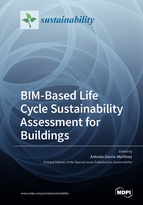BIM-Based Life Cycle Sustainability Assessment for Buildings
A special issue of Sustainability (ISSN 2071-1050). This special issue belongs to the section "Sustainable Engineering and Science".
Deadline for manuscript submissions: closed (31 December 2021) | Viewed by 35442
Special Issue Editor
Interests: LCA BIM-based method; life cycle sustainability assessment of building and urban systems
Special Issues, Collections and Topics in MDPI journals
Special Issue Information
Dear Colleagues,
The activity carried out by the construction sector produces huge environmental, social and economic consequences at local, regional and global levels. In order to contribute to the optimization of the impacts of this essential activity, numerous current investigations try to analyze and evaluate building and construction alternatives, using different methodological approaches. Many of these research projects are based on the use of the life cycle sustainability assessment framework, which has turned out to be a set of useful methodologies that are effective for analysis and evaluation. However, the application of these tools and procedures generally consumes a large amount of time, energy and resources when applied to construction and building systems, mainly due to the qualitative and quantitative complexity of the building phenomenon. Fortunately, in recent years, the use of building information modeling (BIM) platforms have proven to be an innovative, useful and effective aid to the development of building assessments, especially in the process of calculating inventories, obtaining and visualizing results and, more recently, optimizing systems from the life cycle perspective. In order to present the current approaches and trends in this field and to show their practical applications, this Special Issue will compile a selection of research projects that use BIM platforms as a methodological basis and are carried out in the context of the environmental, economic and social assessment of construction, building and urban systems.
Prof. Dr. Antonio Garcia-Martinez
Guest Editor
Manuscript Submission Information
Manuscripts should be submitted online at www.mdpi.com by registering and logging in to this website. Once you are registered, click here to go to the submission form. Manuscripts can be submitted until the deadline. All submissions that pass pre-check are peer-reviewed. Accepted papers will be published continuously in the journal (as soon as accepted) and will be listed together on the special issue website. Research articles, review articles as well as short communications are invited. For planned papers, a title and short abstract (about 100 words) can be sent to the Editorial Office for announcement on this website.
Submitted manuscripts should not have been published previously, nor be under consideration for publication elsewhere (except conference proceedings papers). All manuscripts are thoroughly refereed through a single-blind peer-review process. A guide for authors and other relevant information for submission of manuscripts is available on the Instructions for Authors page. Sustainability is an international peer-reviewed open access semimonthly journal published by MDPI.
Please visit the Instructions for Authors page before submitting a manuscript. The Article Processing Charge (APC) for publication in this open access journal is 2400 CHF (Swiss Francs). Submitted papers should be well formatted and use good English. Authors may use MDPI's English editing service prior to publication or during author revisions.
Keywords
- Building information modeling (BIM)
- Environmental impact assessment
- Life cycle sustainability assessment (LCSA)
- Life cycle assessment (LCA)
- Life cycle cost (LCC)
- Social life cycle assessment (S-LCA)
- Geographical information system (GIS)
- Embodied and operational environmental impacts
- Integration and visualization
- BIM–LCA integration tools
- Sustainable building






